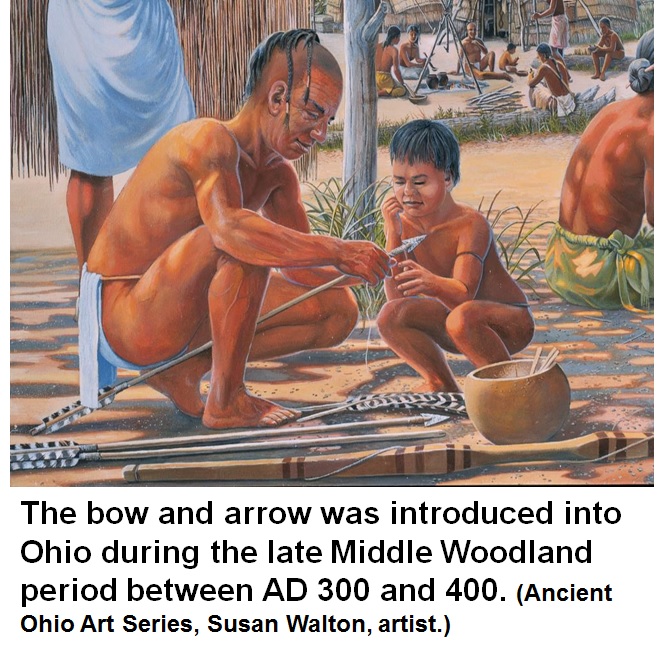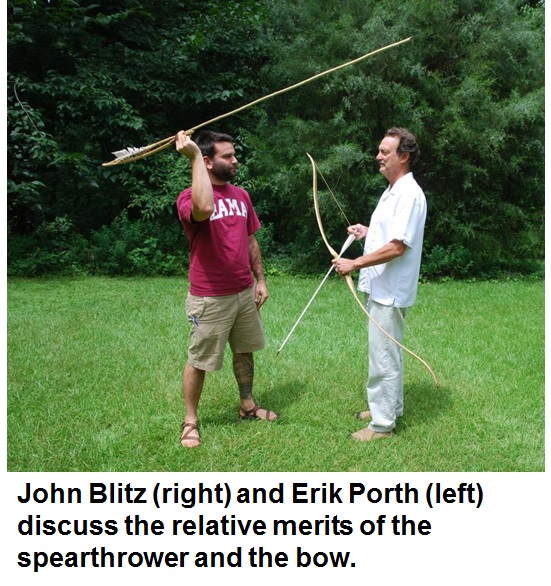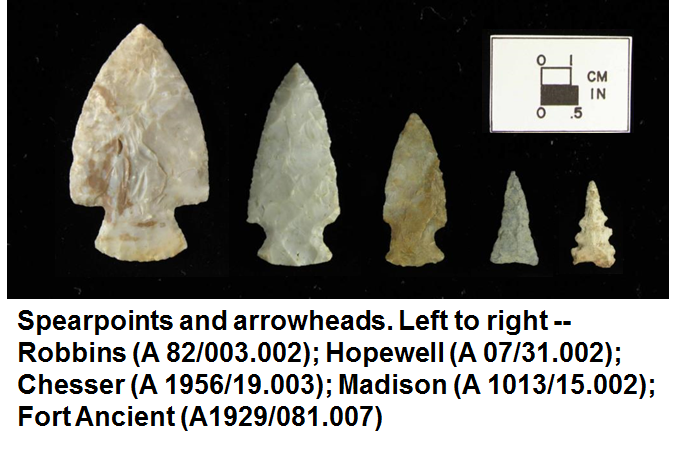 The bow and arrow is so powerfully linked to popular stereotypes of American Indians that most people tend to refer to any flint point they come across as an arrowhead. Actually, the vast majority of flint points found across the Americas were spearpoints (or knives). The bow and arrow was a late invention and it didn’t show up in Ohio until A.D. 300 at the earliest. So the only stone points around for more than 90% of prehistory were spearpoints, not arrowheads. The bow and arrow appears to have rapidly replaced the spear and atlatl (or spearthrower) across much of North America, so the new weapon system must have offered some clear advantages. Just exactly what those advantages were is a matter of some debate.
The bow and arrow is so powerfully linked to popular stereotypes of American Indians that most people tend to refer to any flint point they come across as an arrowhead. Actually, the vast majority of flint points found across the Americas were spearpoints (or knives). The bow and arrow was a late invention and it didn’t show up in Ohio until A.D. 300 at the earliest. So the only stone points around for more than 90% of prehistory were spearpoints, not arrowheads. The bow and arrow appears to have rapidly replaced the spear and atlatl (or spearthrower) across much of North America, so the new weapon system must have offered some clear advantages. Just exactly what those advantages were is a matter of some debate. Regardless of precisely why the bow was preferred, a new theory proposes that its introduction changed just about everything for those ancient cultures who adopted it and, eventually, for those that didn’t. I review this new idea, known as Social Coercion Theory, in my August column in the Columbus Dispatch, but you can read all the gory details in the May/June 2013 issue of the journal Evolutionary Anthropology, which is largely devoted to evaluating the theory. One of the articles in the issue considers what happened in eastern North America in the light of Social Coercion Theory. The authors, John Blitz and Erik Porth, conclude that the evidence fits the predictions of the theory: “In the Eastern Woodlands, the bow was a catalyst for the important social transformations of the Late Woodland period and a prerequisite for accelerating social complexity.” Blitz and Porth describe the transition from spearpoints to early arrowheads, which were smaller than the spearpoints, but otherwise not much different, followed by the introduction of a more refined and specialized arrowhead that may have been introduced into the region from elsewhere. In the attached figure, I use flint points from the collections of the Ohio Historical Society to illustrate this sequence.
Regardless of precisely why the bow was preferred, a new theory proposes that its introduction changed just about everything for those ancient cultures who adopted it and, eventually, for those that didn’t. I review this new idea, known as Social Coercion Theory, in my August column in the Columbus Dispatch, but you can read all the gory details in the May/June 2013 issue of the journal Evolutionary Anthropology, which is largely devoted to evaluating the theory. One of the articles in the issue considers what happened in eastern North America in the light of Social Coercion Theory. The authors, John Blitz and Erik Porth, conclude that the evidence fits the predictions of the theory: “In the Eastern Woodlands, the bow was a catalyst for the important social transformations of the Late Woodland period and a prerequisite for accelerating social complexity.” Blitz and Porth describe the transition from spearpoints to early arrowheads, which were smaller than the spearpoints, but otherwise not much different, followed by the introduction of a more refined and specialized arrowhead that may have been introduced into the region from elsewhere. In the attached figure, I use flint points from the collections of the Ohio Historical Society to illustrate this sequence. 
The Robbins spearpoint (A 82/000003.002) is typical of the late Adena culture, which dates from about 500 B.C. to A.D. 200. The specimen in the figure is 46 mm wide.
The Hopewell point (A 07/000031.002) is a smaller spearpoint typical of the Hopewell culture in Ohio from about 100 B.C. to A.D. 400. The specimen in the figure is 36 mm wide. Blitz and Porth would regard the Chesser Notched point (A 1956/000019.003) as an early arrowhead. It dates to the Late Woodland period or between around A.D. 300 and 700. The design is clearly derived from the larger Hopewell spearpoints, but it is significantly smaller. This specimen is 23 mm wide. The Madison point (A 1013/000015.002) is an example of a Late Woodland to Late Prehistoric arrowpoint. It dates to between A.D. 800 and 1450. According to Blitz and Porth, these refined triangular points have “no obvious indigenous prototypes or transitional forms” in the Ohio region. They speculate that they are derived from earlier triangular points from sites farther west. This specimen is 16 mm wide. The Fort Ancient point (A 1929/000081.007) dates to between A.D. 1100 1450. It is 15 mm wide. According to Blitz and Porth, this point would be representative of a “new diversity of arrowpoint forms” that also seem to originate in the west perhaps on the Great Plains. The serrations and barbs would have made the point difficult to extract from a wound suggesting it was intended mainly to be used against people. Certainly, there is increasing evidence for violent conflict during this period. Blitz and Porth also see a link between the adoption of the bow and the increasing importance of maize as a staple food. John shared the following thoughts with me in an e-mail: “Adoption of the bow gave families greater economic independence by changing hunting strategies so that fewer people were needed to hunt efficiently. This change allowed families to settle permanently in locations that had only been used as temporary foraging areas previously. However, over time, as the landscape filled and populations grew in Late Woodland times, people had to get more resources from smaller territories, or face conflict with their neighbors, made more deadly by the widespread use of the bow (and perhaps more powerful bows). So they began to intensify corn production to fill the need. Erik and I argue that this is why corn was merely a supplementary food for several centuries until rapidly expanded in the Late Woodland period in the Midwest.” Ultimately, perhaps inevitably, the upward (or downward depending on your point of view) spiral of agricultural intensification and militarization initiated by the adoption of the bow — resulted in the rise of centralized authority during the Mississippian period. And although there were no Mississippian temple mound centers in Ohio, Rob Cooks research at SunWatchVillage in Dayton suggests it might only have been a matter of time before that level of socio-cultural complexity developed here, too. Of course well never know what might have been, because the arrival of Europeans with their infamous guns, germs and steel violently derailed American Indian cultural history in the OhioValley. The Social Coercion Theory is a compelling explanation for the rise of social complexity generally and it seems to work for the Eastern Woodlands. If you’re interested in the topic I recommend to your attention all the articles in the latest issue of Evolutionary Anthropology. Brad Lepper